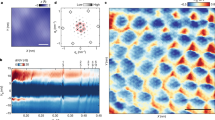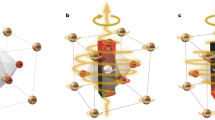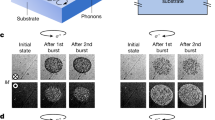Abstract
The control of molecules is key to the investigation of quantum phases, in which rich degrees of freedom can be used to encode information and strong interactions can be precisely tuned1. Inelastic losses in molecular collisions2,3,4,5, however, have greatly hampered the engineering of low-entropy molecular systems6. So far, the only quantum degenerate gas of molecules has been created via association of two highly degenerate atomic gases7,8. Here we use an external electric field along with optical lattice confinement to create a two-dimensional Fermi gas of spin-polarized potassium–rubidium (KRb) polar molecules, in which elastic, tunable dipolar interactions dominate over all inelastic processes. Direct thermalization among the molecules in the trap leads to efficient dipolar evaporative cooling, yielding a rapid increase in phase-space density. At the onset of quantum degeneracy, we observe the effects of Fermi statistics on the thermodynamics of the molecular gas. These results demonstrate a general strategy for achieving quantum degeneracy in dipolar molecular gases in which strong, long-range and anisotropic dipolar interactions can drive the emergence of exotic many-body phases, such as interlayer pairing and p-wave superfluidity.
This is a preview of subscription content, access via your institution
Access options
Access Nature and 54 other Nature Portfolio journals
Get Nature+, our best-value online-access subscription
$29.99 / 30 days
cancel any time
Subscribe to this journal
Receive 51 print issues and online access
$199.00 per year
only $3.90 per issue
Buy this article
- Purchase on Springer Link
- Instant access to full article PDF
Prices may be subject to local taxes which are calculated during checkout




Similar content being viewed by others
Data availability
The data that support the findings of this study are available from the corresponding author upon reasonable request. Source data are provided with this paper.
References
Bohn, J. L., Rey, A. M. & Ye, J. Cold molecules: progress in quantum engineering of chemistry and quantum matter. Science 357, 1002–1010 (2017).
Ospelkaus, S. et al. Quantum-state controlled chemical reactions of ultracold potassium-rubidium molecules. Science 327, 853–857 (2010).
Ni, K.-K. et al. Dipolar collisions of polar molecules in the quantum regime. Nature 464, 1324–1328 (2010).
Guo, M. et al. Dipolar collisions of ultracold ground-state bosonic molecules. Phys. Rev. X 8, 041044 (2018).
Gregory, P. D. et al. Sticky collisions of ultracold RbCs molecules. Nat. Commun. 10, 3104 (2019).
Moses, S. A. et al. Creation of a low-entropy quantum gas of polar molecules in an optical lattice. Science 350, 659–662 (2015).
De Marco, L. et al. A degenerate Fermi gas of polar molecules. Science 363, 853–856 (2019).
Tobias, W. G. et al. Thermalization and sub-Poissonian density fluctuations in a degenerate molecular Fermi gas. Phys. Rev. Lett. 124, 033401 (2020).
André, A. et al. A coherent all-electrical interface between polar molecules and mesoscopic superconducting resonators. Nat. Phys. 2, 636–642 (2006).
DeMille, D., Doyle, J. M. & Sushkov, A. O. Probing the frontiers of particle physics with tabletop-scale experiments. Science 357, 990–994 (2017).
Gregory, P. D., Blackmore, J. A., Bromley, S. L. & Cornish, S. L. Loss of ultracold 87Rb133Cs molecules via optical excitation of long-lived two-body collision complexes. Phys. Rev. Lett. 124, 163402 (2020).
Hu, M. G. et al. Direct observation of bimolecular reactions of ultracold KRb molecules. Science 366, 1111–1115 (2019).
Kirste, M. et al. Quantum-state resolved bimolecular collisions of velocity-controlled OH with NO radicals. Science 338, 1060–1063 (2012).
Christianen, A., Zwierlein, M. W., Groenenboom, G. C. & Karman, T. Photoinduced two-body loss of ultracold molecules. Phys. Rev. Lett. 123, 123402 (2019).
Danzl, J. G. et al. Quantum gas of deeply bound ground state molecules. Science 321, 1062–1066 (2008).
Seeßelberg, F. et al. Extending rotational coherence of interacting polar molecules in a spin-decoupled magic trap. Phys. Rev. Lett. 121, 253401 (2018).
Will, S. A., Park, J. W., Yan, Z. Z., Loh, H. & Zwierlein, M. W. Coherent microwave control of ultracold 23Na40K molecules. Phys. Rev. Lett. 116, 225306 (2016).
Barry, J. F., McCarron, D. J., Norrgard, E. B., Steinecker, M. H. & Demille, D. Magneto-optical trapping of a diatomic molecule. Nature 512, 286–289 (2014).
Truppe, S. et al. Molecules cooled below the Doppler limit. Nat. Phys. 13, 1173–1176 (2017).
Anderegg, L. et al. An optical tweezer array of ultracold molecules. Science 365, 1156–1158 (2019).
Ding, S., Wu, Y., Finneran, I. A., Burau, J. J. & Ye, J. Sub-Doppler cooling and compressed trapping of YO molecules at μK temperatures. Phys. Rev. X 10, 021049 (2020).
Yang, H. et al. Observation of magnetically tunable Feshbach resonances in ultracold 23Na40K + 40K collisions. Science 363, 261–264 (2019).
Son, H., Park, J. J., Ketterle, W. & Jamison, A. O. Collisional cooling of ultracold molecules. Nature 580, 197–200 (2020).
Segev, Y. et al. Collisions between cold molecules in a superconducting magnetic trap. Nature 572, 189–193 (2019).
Baranov, M. A., Dalmonte, M., Pupillo, G. & Zoller, P. Condensed matter theory of dipolar quantum gases. Chem. Rev. 112, 5012–5061 (2012).
Aikawa, K. et al. Reaching Fermi degeneracy via universal dipolar scattering. Phys. Rev. Lett. 112, 010404 (2014).
DeMarco, B. & Jin, D. S. Onset of Fermi degeneracy in a trapped atomic gas. Science 285, 1703–1706 (1999).
Quéméner, G. & Bohn, J. L. Dynamics of ultracold molecules in confined geometry and electric field. Phys. Rev. A 83, 012705 (2011).
Micheli, A. et al. Universal rates for reactive ultracold polar molecules in reduced dimensions. Phys. Rev. Lett. 105, 073202 (2010).
Zhu, B., Quéméner, G., Rey, A. M. & Holland, M. J. Evaporative cooling of reactive polar molecules confined in a two-dimensional geometry. Phys. Rev. A 88, 063405 (2013).
de Miranda, M. H. G. et al. Controlling the quantum stereodynamics of ultracold bimolecular reactions. Nat. Phys. 7, 502–507 (2011).
Covey, J. P. Enhanced Optical and Electric Manipulation of a Quantum Gas of KRb Molecules. Thesis, Univ. Colorado, https://doi.org/10.1007/978-3-319-98107-9 (2018).
Shvarchuck, I. et al. Bose–einstein condensation into nonequilibrium states studied by condensate focusing. Phys. Rev. Lett. 89, 270404 (2002).
Hueck, K. et al. Two-dimensional homogeneous Fermi gases. Phys. Rev. Lett. 120, 060402 (2018).
Ni, K.-K. et al. A high phase-space-density gas of polar molecules. Science 322, 231–235 (2008).
Quéméner, G. & Bohn, J. L. Strong dependence of ultracold chemical rates on electric dipole moments. Phys. Rev. A 81, 022702 (2010).
Bohn, J. L., Cavagnero, M. & Ticknor, C. Quasi-universal dipolar scattering in cold and ultracold gases. New J. Phys. 11, 055039 (2009).
Ticknor, C. Quasi-two-dimensional dipolar scattering. Phys. Rev. A 81, 042708 (2010).
Bohn, J. L. & Jin, D. S. Differential scattering and rethermalization in ultracold dipolar gases. Phys. Rev. A 89, 022702 (2014).
Aikawa, K. et al. Anisotropic relaxation dynamics in a dipolar Fermi gas driven out of equilibrium. Phys. Rev. Lett. 113, 263201 (2014).
Babadi, M. & Demler, E. Collective excitations of quasi-two-dimensional trapped dipolar fermions: transition from collisionless to hydrodynamic regime. Phys. Rev. A 86, 063638 (2012).
Giorgini, S., Pitaevskii, L. P. & Stringari, S. Theory of ultracold atomic Fermi gases. Rev. Mod. Phys. 80, 1215 (2008).
Büchler, H. P. et al. Strongly correlated 2D quantum phases with cold polar molecules: controlling the shape of the interaction potential. Phys. Rev. Lett. 98, 060404 (2007).
Góral, K., Santos, L. & Lewenstein, M. Quantum phases of dipolar bosons in optical lattices. Phys. Rev. Lett. 88, 170406 (2002).
Capogrosso-Sansone, B., Trefzger, C., Lewenstein, M., Zoller, P. & Pupillo, G. Quantum phases of cold polar molecules in 2D optical lattices. Phys. Rev. Lett. 104, 125301 (2010).
Cooper, N. R. & Shlyapnikov, G. V. Stable topological superfluid phase of ultracold polar fermionic molecules. Phys. Rev. Lett. 103, 155302 (2009).
Gorshkov, A. V. et al. Tunable superfluidity and quantum magnetism with ultracold polar molecules. Phys. Rev. Lett. 107, 115301 (2011).
Potter, A. C., Berg, E., Wang, D. W., Halperin, B. I. & Demler, E. Superfluidity and dimerization in a multilayered system of fermionic polar molecules. Phys. Rev. Lett. 105, 220406 (2010).
Yao, N. Y. et al. Many-body localization in dipolar systems. Phys. Rev. Lett. 113, 243002 (2014).
Barbiero, L., Menotti, C., Recati, A. & Santos, L. Out-of-equilibrium states and quasi-many-body localization in polar lattice gases. Phys. Rev. B 92, 180406 (2015).
Zinner, N. T. & Bruun, G. M. Density waves in layered systems with fermionic polar molecules. Eur. Phys. J. D 65, 133–139 (2011).
Peter, D., Müller, S., Wessel, S. & Büchler, H. P. Anomalous behavior of spin systems with dipolar interactions. Phys. Rev. Lett. 109, 025303 (2012).
Dalfovo, F., Giorgini, S., Pitaevskii, L. P. & Stringari, S. Theory of Bose–Einstein condensation in trapped gases. Rev. Mod. Phys. 71, 463–512 (1999).
Inguscio, M., Ketterle, W. & Salomon, C. Ultra-cold Fermi gases. In Proceedings of the International School of Physics ‘Enrico Fermi’ (2007).
Acknowledgements
We acknowledge funding from NIST, DARPA DRINQS, ARO MURI and NSF Phys-1734006. We thank J. L. Bohn, A. M. Kaufman, and C. Miller for careful reading of the manuscript and T. Brown for technical assistance.
Author information
Authors and Affiliations
Contributions
All authors contributed to carrying out the experiments, interpreting the results, and writing the manuscript.
Corresponding authors
Ethics declarations
Competing interests
The authors declare no competing interests.
Additional information
Peer review information Nature thanks Georgy Shlyapnikov and the other, anonymous, reviewer(s) for their contribution to the peer review of this work.
Publisher’s note Springer Nature remains neutral with regard to jurisdictional claims in published maps and institutional affiliations.
Extended data figures and tables
Extended Data Fig. 1 Layer occupancy.
Histogram of the average number per layer (relative population) for the data shown in Fig. 1c.
Extended Data Fig. 2 Trend of ωx/(2π) versus γ.
Grey points are the experimental measurements at EDC = 5 kV cm−1, the solid grey line is a linear fit to guide the eye, and the dashed line is the prediction (Sim) from the finite-element model. All error bars are 1 standard deviation of the mean.
Extended Data Fig. 3 Evaporation sequence.
a, Ramp in EDC. b, Ramp in γ. c, Trap depth versus time from the finite-element model of electro-optical potential. d, Evolution of η, calculated by taking the ratio of the trap depth and temperature at each time point. e, Evolution of T/TF during the ramp. All error bars are 1 standard error of the mean.
Extended Data Fig. 4 Fermi gas thermometry.
Trend of Tout/Trel as a function of the excluded region from the centre of the Gaussian fit for T/TF = 0.81(15) (orange diamonds) and T/TF = 2.0(1) (black circles). Solid lines are Gaussian fits to simulated density profiles for T/TF = 2.0 (black) and T/TF = 0.8 (orange). All error bars are 1 standard error of the mean.
Rights and permissions
About this article
Cite this article
Valtolina, G., Matsuda, K., Tobias, W.G. et al. Dipolar evaporation of reactive molecules to below the Fermi temperature. Nature 588, 239–243 (2020). https://doi.org/10.1038/s41586-020-2980-7
Received:
Accepted:
Published:
Issue Date:
DOI: https://doi.org/10.1038/s41586-020-2980-7
This article is cited by
-
Tunable itinerant spin dynamics with polar molecules
Nature (2023)
-
Studying spin physics with moving molecules
Nature (2023)
-
Transition from a polaronic condensate to a degenerate Fermi gas of heteronuclear molecules
Nature Physics (2023)
-
Collisionally stable gas of bosonic dipolar ground-state molecules
Nature Physics (2023)
-
A new route to associating ultracold polar molecules in the absolute ground state
Science China Physics, Mechanics & Astronomy (2023)
Comments
By submitting a comment you agree to abide by our Terms and Community Guidelines. If you find something abusive or that does not comply with our terms or guidelines please flag it as inappropriate.



